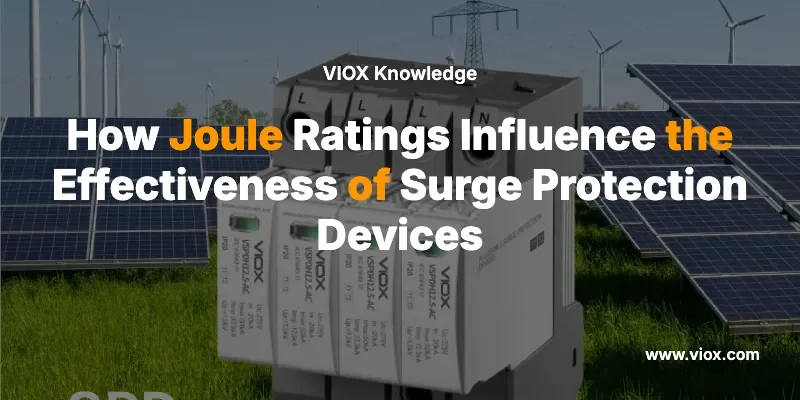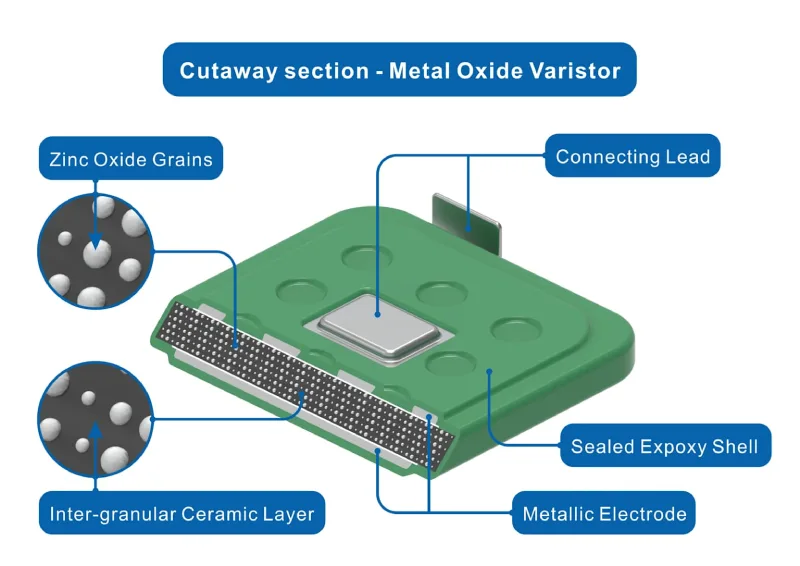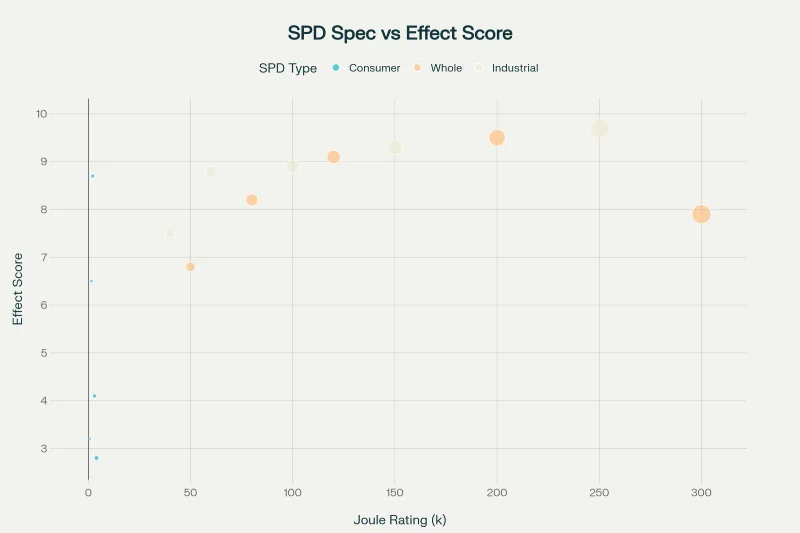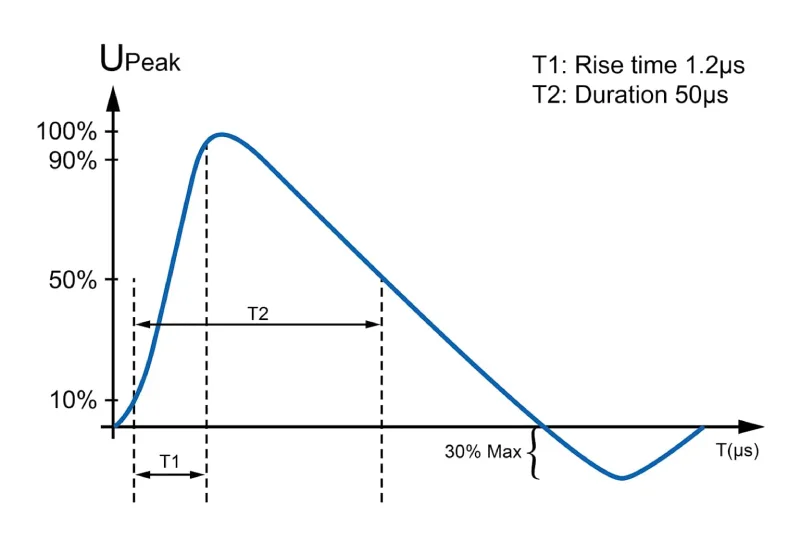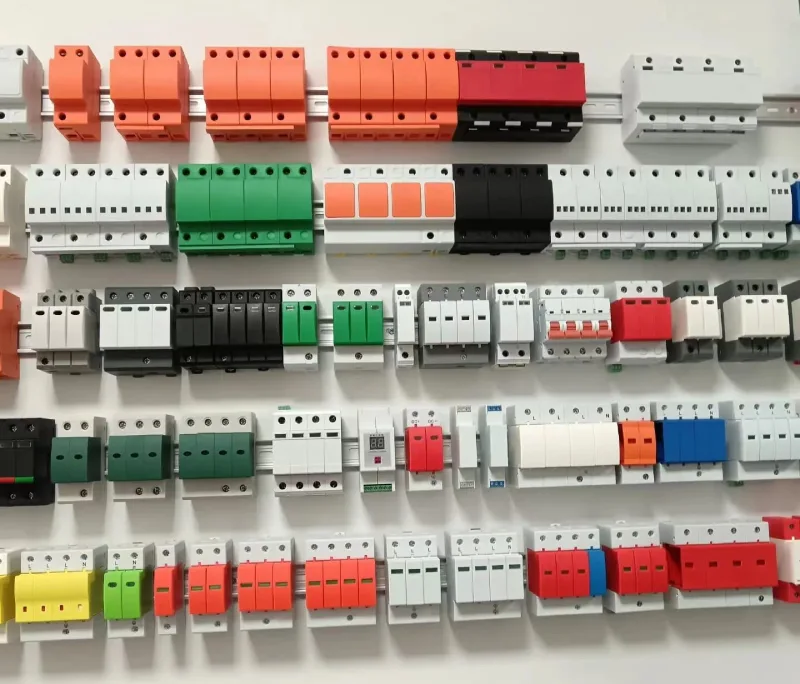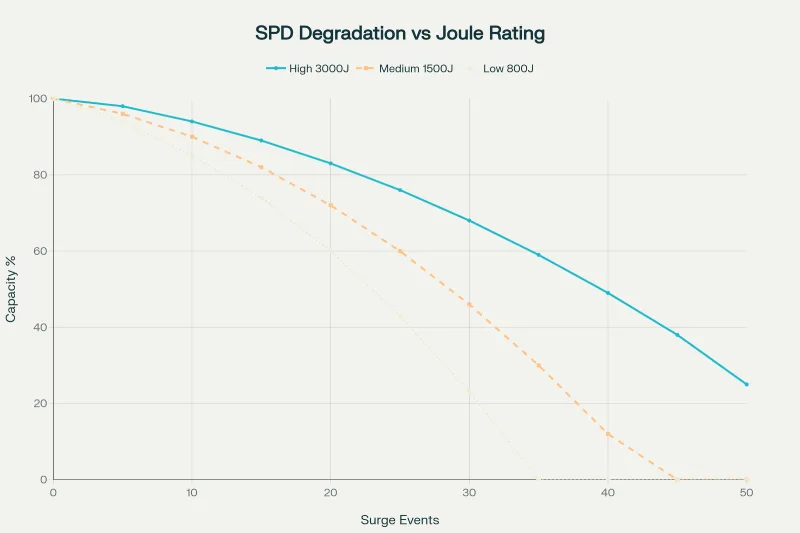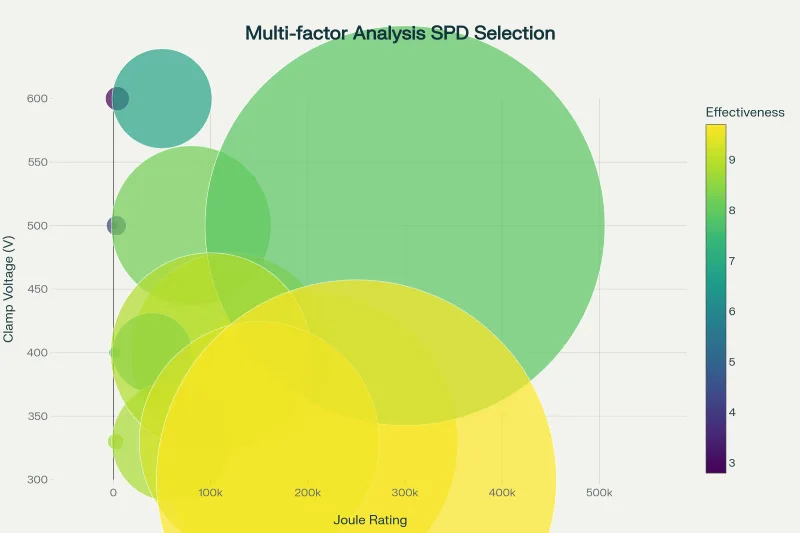Understanding Joule Ratings in Surge Protection Context
Нь Joule rating indicates the cumulative energy absorption capacity of a surge protection device before it fails or degrades significantly. Measured in Joules (watt-seconds), this rating theoretically represents how much surge energy the device can absorb over its entire service life. However, this seemingly straightforward metric masks several critical limitations that affect its utility in determining SPD effectiveness.
The energy absorption capability depends primarily on the Металл ислийн варисторууд (MOVs) within the SPD, which are the key components responsible for clamping surge voltages. The Joule rating is determined by the quantity, size, and quality of these MOVs working in parallel configurations.
The Fundamental Limitation: Joule Ratings vs. Protection Quality
Industry Position on Joule Ratings
Major manufacturers and industry standards organizations explicitly reject Joule ratings as reliable indicators of SPD effectiveness. Schneider Electric, a leading SPD manufacturer, states unequivocally that “Joule ratings are not a recognized or reliable metric for determining the effectiveness or performance of a Surge Protective Device”. Similarly, NEMA’s Surge Protection Institute acknowledges that “more reputable manufacturers no longer provide energy ratings” due to their misleading nature.
The IEEE Standard C62.62 specifically states that response time specifications, often conflated with energy ratings, “should not be used as a specification” for SPDs. This industry-wide consensus reflects decades of experience demonstrating that Joule ratings fail to predict actual protection performance.
The Misleading Nature of Energy Ratings
Joule ratings can be artificially inflated through testing methodologies that don’t reflect real-world surge conditions. There is no standardized method for measuring SPD energy ratings, allowing manufacturers to use extended pulse durations or favorable test conditions to generate impressive but meaningless numbers. Some manufacturers have been known to use “long tail pulses to provide larger results, misleading the end users”.
SPD Specifications vs Effectiveness Analysis
The analysis reveals that higher Joule ratings do not consistently correlate with better protection effectiveness. Consumer surge protectors with ratings of 800-4000 Joules show varied effectiveness scores that don’t align with their energy ratings, while professional-grade SPDs focus on entirely different specifications.
Primary Factors Determining SPD Effectiveness
Clamping Voltage (Voltage Protection Rating)
The most critical factor in SPD effectiveness is the clamping voltage, now standardized as the Voltage Protection Rating (VPR). This specification, measured using UL 1449 testing with a 6kV, 3kA combination wave, directly determines the voltage level that reaches protected equipment during a surge event.
VPR ratings are standardized at specific levels (330V, 400V, 500V, 600V, 700V, 800V, 1000V, 1200V, 1500V, 2000V), providing a consistent basis for comparing SPD performance. Lower VPR values provide superior protection because they limit the surge voltage reaching sensitive equipment to safer levels.
The relationship between VPR and equipment protection is based on the Information Technology Industry Council (ITIC) voltage tolerance curve, which indicates that electronic equipment can typically withstand voltages up to 500% of nominal for very brief durations. Therefore, SPDs with VPR ratings significantly below this threshold provide the most effective protection.
Surge Current Rating (kA Rating)
The surge current rating, measured in kiloamperes (kA), indicates the maximum surge current the SPD can safely handle. This rating, verified through UL 1449 testing, directly relates to the SPD’s ability to survive large surge events without failure.
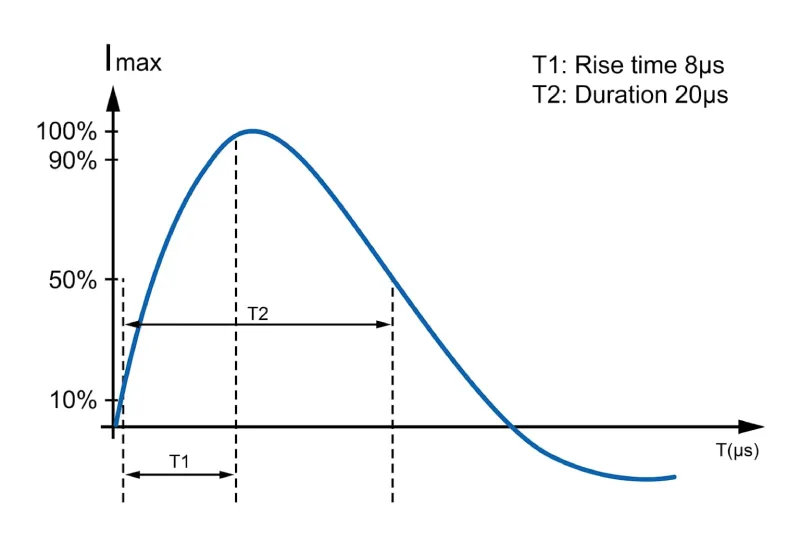
Professional SPDs typically offer surge current ratings from 50kA to 200kA or higher, while consumer devices may range from 4kA to 15kA. Higher kA ratings provide better protection against large surge events and extend SPD service life by preventing premature failure during significant lightning-induced surges.
The surge current rating also relates to the SPD’s ability to coordinate with other protective devices in a cascaded protection scheme, where multiple SPDs work together to provide comprehensive protection.
Хамгийн их тасралтгүй ажиллах хүчдэл (MCOV)
MCOV represents the highest steady-state voltage the SPD can withstand without activating or becoming a safety hazard. This specification is crucial for preventing premature SPD degradation due to normal voltage variations and temporary overvoltages.
Professional guidelines recommend selecting SPDs with MCOV ratings at least 115% of the nominal system voltage to ensure reliable operation under normal conditions. SPDs with insufficient MCOV ratings may activate repeatedly during normal voltage fluctuations, leading to premature wear and potential safety hazards.
Industry Standards and Testing Methodologies
UL 1449 Standard Requirements
UL 1449, the definitive safety and performance standard for SPDs, focuses entirely on VPR, surge current ratings, and MCOV – not Joule ratings. The standard’s testing methodology subjects SPDs to rigorous evaluation including:
- Voltage Protection Rating (VPR) Testing: Using 6kV, 3kA combination waves to determine let-through voltage
- Nominal Discharge Current Testing: Applying 15 surges at rated current levels to verify continued functionality
- Temporary Overvoltage Testing: Ensuring safe operation during sustained overvoltage conditions
The standard’s emphasis on these parameters reflects their direct relationship to protection effectiveness, while the absence of Joule rating requirements underscores their limited relevance to actual performance.
IEEE C62.41 Testing Environment
IEEE C62.41 defines the surge environment and recommended test waveforms for evaluating SPD performance. This standard establishes three location categories (A, B, C) based on proximity to the service entrance, with corresponding surge exposure levels and appropriate test waveforms.
The standard’s recommended waveforms (combination wave, ring wave, and others) are designed to simulate realistic surge conditions rather than optimize for energy absorption measurements. This approach emphasizes the importance of protection effectiveness over cumulative energy handling capacity.
Professional SPD Selection Criteria
Whole-House and Industrial Applications
Professional SPD installations prioritize surge current ratings and VPR specifications over Joule ratings. Service entrance SPDs typically feature:
- Surge current ratings: 50kA to 200kA or higher
- VPR ratings: 330V to 600V depending on system voltage
- MCOV ratings: Properly matched to system voltage with adequate margin
- UL 1449 Type 1 or Type 2 certification: Ensuring compliance with safety standards
The focus on these parameters reflects their direct impact on protection effectiveness and system safety, while Joule ratings are considered secondary indicators of device longevity rather than protection quality.
Cascaded Protection Systems
Professional installations employ cascaded protection schemes where multiple SPDs work together to provide comprehensive surge protection. In these systems:
- Service entrance SPDs: Handle the largest surge currents with high kA ratings
- Panel-mounted SPDs: Provide secondary protection with moderate kA ratings
- Point-of-use SPDs: Offer final protection with lower kA ratings but superior VPR performance
This approach recognizes that effective surge protection depends on coordinated voltage clamping rather than cumulative energy absorption, further diminishing the relevance of Joule ratings in professional applications.
The Role of Joule Ratings in SPD Lifespan
Energy Absorption and Device Degradation
While Joule ratings don’t determine protection effectiveness, they do influence SPD service life. Higher Joule ratings generally indicate greater cumulative energy absorption capacity, which can extend device lifespan under repeated surge exposure.
The degradation analysis demonstrates that SPDs with higher Joule ratings maintain functionality longer under repeated surge events, but all provide equivalent protection quality when operational. This relationship explains why Joule ratings remain relevant for replacement scheduling and maintenance planning, even though they don’t affect protection effectiveness.
MOV Degradation Mechanisms
SPD degradation occurs through cumulative damage to MOVs from repeated surge events. Each surge event causes incremental damage to the zinc oxide grain boundaries within MOVs, gradually reducing their effectiveness. Higher Joule ratings typically indicate larger or more numerous MOVs, providing greater reserve capacity before significant degradation occurs.
However, this degradation process affects device lifespan rather than protection effectiveness, since all SPDs provide equivalent voltage clamping when properly sized and functioning within their ratings.
Common Misconceptions and Marketing Practices
Consumer Market Confusion
The consumer surge protector market heavily emphasizes Joule ratings despite their limited relevance to protection effectiveness. This marketing approach creates several misconceptions:
- Higher Joule ratings equal better protection: False – protection effectiveness depends on VPR and response characteristics
- Joule ratings indicate surge handling capacity: Misleading – surge current ratings (kA) determine actual surge handling capability
- Energy absorption equals protection quality: Incorrect – voltage clamping determines protection effectiveness
Professional vs. Consumer Specifications
Professional SPDs typically de-emphasize or omit Joule ratings entirely, focusing instead on performance specifications. This approach reflects the industry understanding that:
- VPR directly determines protection effectiveness
- Surge current ratings indicate device robustness
- MCOV ensures safe continuous operation
- Joule ratings primarily affect replacement intervals
The contrast between professional and consumer specifications highlights the disconnect between marketing-driven energy ratings and actual protection performance.
Technical Analysis and Performance Correlation
Weak Correlation Between Joule Ratings and Effectiveness
Comprehensive analysis reveals minimal correlation between Joule ratings and actual SPD effectiveness.
The data shows that:
- Consumer SPDs: Effectiveness scores vary significantly despite similar Joule ratings
- Professional SPDs: Higher effectiveness correlates with lower VPR and higher kA ratings, not Joule ratings
- Industrial SPDs: Superior performance reflects advanced MOV technology and circuit design rather than energy capacity
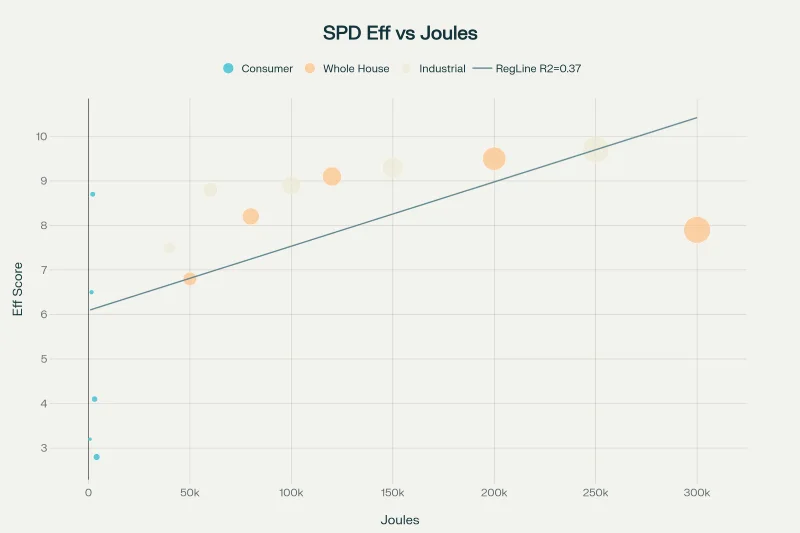
This analysis confirms that Joule ratings are poor predictors of protection effectiveness, while VPR and surge current ratings show strong correlation with actual performance.
Multi-Factor Performance Analysis
Effective SPD selection requires considering multiple interrelated factors rather than relying on single specifications.
The comprehensive evaluation framework includes:
- Primary factors: VPR, surge current rating, MCOV
- Secondary factors: Response time, Joule rating, physical design
- Safety factors: UL 1449 compliance, end-of-life protection, installation requirements
This multi-factor approach ensures optimal protection effectiveness while avoiding the limitations of single-parameter selection based on Joule ratings.
Recommendations for SPD Selection
Professional Selection Guidelines
Proper SPD selection should prioritize proven performance indicators over marketing-driven specifications:
- Primary consideration: Select SPDs with VPR ratings appropriate for protected equipment vulnerability
- Surge capacity: Choose surge current ratings based on installation location and exposure level
- Operating parameters: Ensure MCOV ratings provide adequate margin above system voltage
- Standards compliance: Verify UL 1449 certification for safety and performance validation
- Secondary consideration: Consider Joule ratings for maintenance scheduling and replacement planning
Хэрэглээний тусгай зөвлөмжүүд
Different applications require tailored approaches to SPD selection:
- Residential applications: Focus on VPR ≤ 400V and surge current ratings ≥ 40kA for service entrance
- Арилжааны суурилуулалт: Prioritize VPR ≤ 330V and surge current ratings ≥ 80kA for main panels
- Аж үйлдвэрийн байгууламжууд: Emphasize VPR ≤ 300V and surge current ratings ≥ 100kA for critical equipment protection
- Дата төвүүд: Require VPR ≤ 330V with fast response times and high surge current ratings
Дүгнэлт
Joule ratings have minimal influence on SPD effectiveness, serving primarily as indicators of device longevity rather than protection quality. The extensive analysis reveals that while Joule ratings reflect cumulative energy absorption capacity, they do not determine the SPD’s ability to protect connected equipment from surge damage.
The most critical factors influencing SPD effectiveness are clamping voltage (VPR), surge current rating, and maximum continuous operating voltage (MCOV). These parameters, standardized through UL 1449 testing, directly impact protection performance and safety. Professional SPD manufacturers and industry standards organizations consistently prioritize these specifications over Joule ratings when evaluating protection effectiveness.
For optimal surge protection, selection decisions should be based on proven performance indicators validated through recognized testing standards. While Joule ratings may inform maintenance scheduling and replacement planning, they should not be the primary factor in determining SPD effectiveness. Understanding this distinction is crucial for implementing effective surge protection strategies that truly safeguard sensitive electronic equipment from surge damage.
The evidence clearly demonstrates that effective surge protection depends on voltage clamping performance and surge current handling capacity, not cumulative energy absorption. This understanding should guide all SPD selection decisions, ensuring that protection effectiveness takes precedence over marketing-driven specifications that may not reflect actual performance capabilities.
Холбоотой
Хэт хүчдэлээс хамгаалах төхөөрөмж (SPD) гэж юу вэ
Хүчдэлээс хамгаалах төхөөрөмжүүд: давуу болон сул талууд

